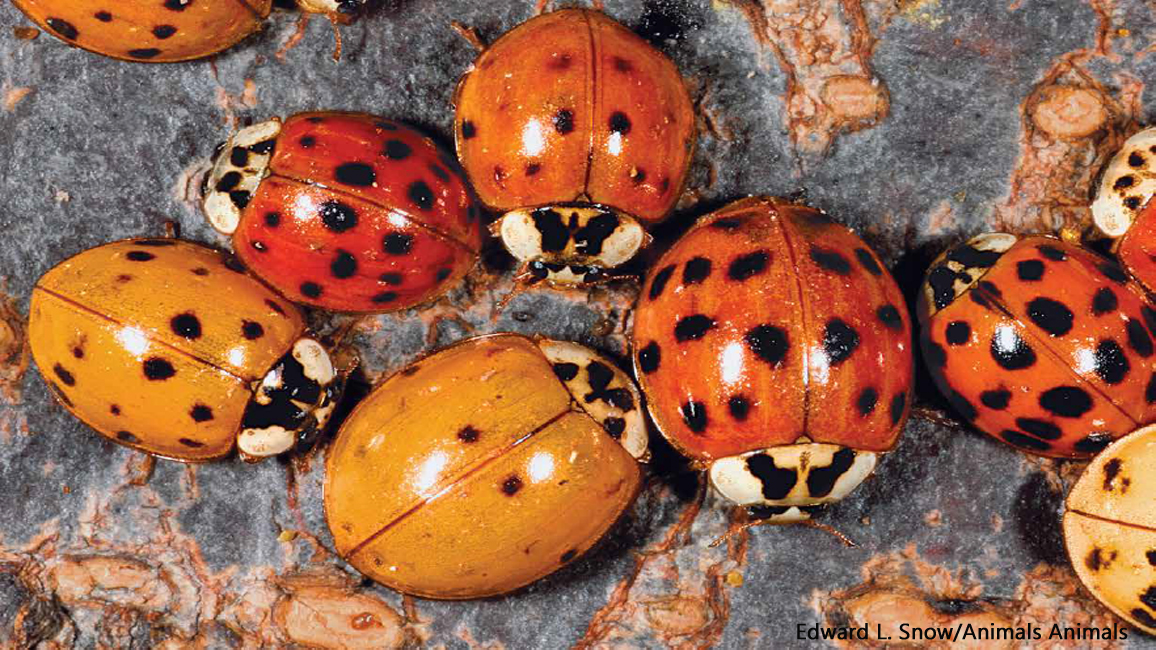
10 Big Surprises About Ladybugs
By Kathy KrankingHere are some things you may not know about these colorful cuties.
1. They Aren’t All Ladies
Ladybugs go by different names: ladybird, ladybird beetle, lady beetle, lady fly, and others.
But no matter what you call them, they aren’t all ladies!
Plenty of ladybugs are males.
So how do you tell which is which?
Well, male ladybugs are slightly smaller than females.
But unless you have a male and female of the same species right next to each other, it’s really hard to tell them apart.
Good thing the ladybugs can tell!
2. They Aren’t Even Bugs!
Lots of people call all insects “bugs.” But only some of them are really bugs.
True bugs each have a long, thin beak that works like a straw. They use it to pierce and suck up their food.
But ladybugs have chewing mouthparts to eat their food.
They’re beetles, not bugs.
3. They’re Not All Red with Black Spots
Ladybugs can come in many colors, including red, orange, black, yellow, pink, and white.
And their spots aren’t always black. Some don’t even have spots—they may have stripes or no markings at all!
4. They Have Thin, Hide-Away Wings
You may have seen a ladybug fly. It just lifts its colorful wings and takes off, right? Well, surprise!
The colorful parts are the ladybug’s forewings, called elytra (EL-ih-truh), and they aren’t used for flying.
These hard, shell-like wings protect the thin, delicate hindwings.
When the ladybug lifts its elytra, its hindwings unfold for flying.
5. They’re BIG Eaters
Ladybugs eat tiny insects and insect eggs.
Their favorite food is aphids. Aphids are insects that suck the juices out of crops and other plants. Too many in one place can damage or kill the plants.
But one ladybug can eat as many as 5,000 aphids in its lifetime!
So ladybugs are special favorites of farmers and gardeners.
☀️ Want to help out garden bugs? Build a bug hotel!
6. Their Colors Are a Warning
A ladybug’s bright colors don’t just look pretty. They send an important message.
As with some other brightly colored animals, the ladybugs’ colors say, “I taste really bad!”
Some predators may see the colors and decide to find a better-tasting meal.
7. They’re Fakers
What if a predator ignores a ladybug’s warning colors and goes after it anyway?
The ladybug plays a good trick: It flips onto its back and plays dead!
Many predators prefer live prey, so this may make them leave ladybugs alone.
But in case they don’t, a ladybug goes for the double whammy: It oozes drops of bad-smelling, bad-tasting stuff from its legs.
8. They “Hibernate”
When temperatures drop, it’s time for ladybugs to take their winter naps.
Hundreds or even thousands of ladybugs will cluster together to survive the winter.
They gather in rocky crevices and under tree bark or leaves.
Some even cluster in attics or other parts of people’s houses.
As temperatures warm up in spring, the ladybugs become active and go about their ladybug business.
9. They Are Quick-Change Artists
Just as butterflies do, ladybugs (and other beetles) go through a change called metamorphosis (met-uh-MOR-fuh-sis).
When ladybug larvas hatch from their eggs, they don’t look anything like adult ladybugs.
From the time a larva hatches, it gobbles up as many aphids and other small insects as it can.
As it grows, it sheds its skin several times. Then, when the time is right, the larva attaches itself to a leaf and becomes a pupa (PYOO-puh).
Inside the pupa, big changes happen. And finally—presto, change-o!—an adult ladybug comes out.
10. They Have Copycats
Some kinds of spiders have coloring and markings that make them look like ladybugs.
This could fool predators into thinking that—like ladybugs—the spiders are bad-tasting, too.
So now you know the truth about ladybugs: They’re full of surprises!
☀️ RECIPE: MAKE LADYBUGS YOU CAN EAT!




















